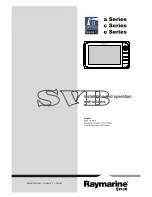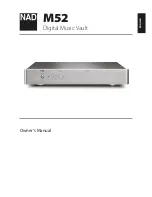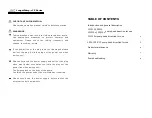
Lake Shore Model 370 AC Resistance Bridge User’s Manual
ground
. A conducting connection, whether intentional or accidental, by which an electric circuit or equipment is connected to the
Earth, or to some conducting body of relatively large extent that serves in place of the Earth.
Note:
It is used for establishing and maintaining the potential of the Earth (or of the conducting body) or approximately that
potential, on conductors connected to it, and for conducting ground current to and from the Earth (or of the conducting body).
2
H
. Symbol for magnetic field strength.
See
Magnetic Field Strength.
Hall effect
. The generation of an electric potential perpendicular to both an electric current flowing along a thin conducting material
and an external magnetic field applied at right angles to the current. Named for Edwin H. Hall (1855
–
1938), an American physicist.
hazard communication standard (HCS)
. The OSHA standard cited in 29 CFR 1910.1200 requiring communication of risks from
hazardous substances to workers in regulated facilities.
hertz (Hz)
. A unit of frequency equal to one cycle per second.
hysteresis
. The dependence of the state of a system on its previous history, generally in the form of a lagging of a physical effect
behind its cause.
1
Also
see
magnetic hysteresis.
I.D.
Inner diameter.
IEC
. International Electrotechnical Commission.
IEEE
. Institute of Electrical and Electronics Engineers.
IEEE-488
. An instrumentation bus with hardware and programming standards designed to simplify instrument interfacing. The
addressable, parallel bus specification is defined by the IEEE.
initial permeability
. The permeability determined at H = 0 and B = 0.
initial susceptibility
. The susceptibility determined at H = 0 and M = 0.
infrared (IR)
. For practical purposes any radiant energy within the wavelength range 770 to 10
6
nanometers is considered infrared
energy.
2
The full range is usually divided into three sub-ranges: near IR, far IR, and sub-millimeter.
input card
. Electronics on a printed circuit board (card) that plug into an instrument main frame. Used by configurable instruments to
allow for different sensor types or interface options.
interchangeability
. Ability to exchange one sensor or device with another of the same type without a significant change in output or
response.
international system of units (SI)
. A universal coherent system of units in which the following seven units are considered basic:
meter, kilogram, second, ampere, Kelvin, mole, and candela. The International System of Units, or Système International d'Unités
(SI), was promulgated in 1960 by the Eleventh General Conference on Weights and Measures. For definition, spelling, and
protocols,
see
Reference 3 for a short, convenient guide.
interpolation table
. A table listing the output and sensitivity of a sensor at regular or defined points which may be different from the
points at which calibration data was taken.
intrinsic coercivity
. The magnetic field strength (H) required to reduce the magnetization (M) or intrinsic induction in a magnetic
material to zero.
intrinsic induction
. The contribution of the magnetic material (B
i
) to the total magnetic induction (B).
B
i
= B – µ
0
H (SI)
B
i
= B – H
(cgs)
IPTS-68
. International Practical Temperature Scale of 1968. Also abbreviated as
T
68
.
isolated
(neutral system). A system that has no intentional connection to ground except through indicating, measuring, or protective
devices of very-high impedance.
2
ITS-90.
International Temperature Scale of 1990. Also abbreviated as
T
90
. This scale was designed to bring into as close a coincidence
with thermodynamic temperatures as the best estimates in 1989 allowed.
Kelvin (K)
. The unit of temperature on the Kelvin Scale. It is one of the base units of SI. The word “degree” and its symbol (°) are
omitted from this unit.
See
Temperature Scale for conversions.
Kelvin Scale
. The Kelvin Thermodynamic Temperature Scale is the basis for all international scales, including the
ITS-90. It is fixed at two points: the absolute zero of temperature (0 K), and the triple point of water (273.16 K), the equilibrium
temperature that pure water reaches in the presence of ice and its own vapor.
line regulation
. The maximum steady-state amount that the output voltage or current changes as result of a specified change in input
line voltage (usually for a step change between 105
–
125 or 210
–
250 volts, unless otherwise specified).
line voltage
. The RMS voltage of the primary power source to an instrument.
liquid helium (LHe)
. Used for low temperature and superconductivity research: minimum purity 99.998%. Boiling point at 1 atm =
4.2 K. Latent heat of vaporization = 2.6 kilojoules per liter. Liquid density = 0.125 kilograms per liter.
EPA Hazard Categories: Immediate (Acute) Health and Sudden Release of Pressure Hazards
DOT Name: Helium, Refrigerated Liquid
DOT Label: Nonflammable Gas
DOT Class: Nonflammable Gas
DOT ID No.: UN 1963
A-4
Glossary of Terminology
Содержание 370
Страница 22: ...Lake Shore Model 370 AC Resistance Bridge User s Manual 1 12 Introduction This Page Intentionally Left Blank ...
Страница 60: ...Lake Shore Model 370 AC Resistance Bridge User s Manual 3 16 Installation This Page Intentionally Left Blank ...
Страница 106: ...Lake Shore Model 370 AC Resistance Bridge User s Manual 5 12 Advanced Operation This Page Intentionally Left Blank ...









































